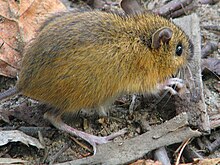Napaeozapus
| Woodland jumping mouse Temporal range: Middle to Recent |
|
|---|---|
 |
|
| Scientific classification | |
| Kingdom: | Animalia |
| Phylum: | Chordata |
| Class: | Mammalia |
| Order: | Rodentia |
| Family: | Dipodidae |
| Subfamily: | Zapodinae |
| Genus: |
Napaeozapus Preble, 1899 |
| Species: | N. insignis |
| Binomial name | |
|
Napaeozapus insignis (Miller, 1891) |
|
The woodland jumping mouse (Napaeozapus insignis) is a species of jumping mouse found in North America. It can hop surprisingly long distances, given its small size. The mouse is an extraordinary part of the rodent family. Its scientific name in Latin is Napaeozapus insignis, meaning glen or wooded dell + big or strong feet + a distinguishing mark. This mammal can jump up to 3 m (9.8 ft) when scared, using its extremely strong feet and long tail.
Representatives of the family Dipodidae are found in the northern regions of the Old and New Worlds, and are characterized by very large infraorbital foramen, and, in one of the two North American genera, Zapus, by 4 upper cheek teeth. Incisors are compressed and deeply grooved. These animals are common and noted for very long tails and long hind legs adapted for leaping. They live in forests, meadows, and swamps and are profound hibernators.
The Woodland jumping mouse was originally classified as Zapus insignis in 1891, but differences detected in dental morphology, ear ossicles, and the baculum resulted in the creation of two new genera, Napaeozapus and Euzapus. At present (2010), N. insignis is in the family Dipodidae but some systematists place woodland jumping mice in their own family, Zapodidae. Dipodidae is divided into seven subfamilies with jumping mice in the subfamily, Zapodinae.
Five subspecies of woodland jumping mice were identified by Whitaker in 1972:
The Woodland jumping mouse occurs throughout northeastern North America from central Manitoba to northern Quebec and south through the Appalachians to northern Georgia.
Populations are most dense in cool, moist boreal woodlands of spruce-fir and hemlock-hardwoods where streams flow from woods to meadows with bankside touch-me-nots (Impatiens) and in situations where meadow and forest intermix and water and thick ground cover are available.
...
Wikipedia

